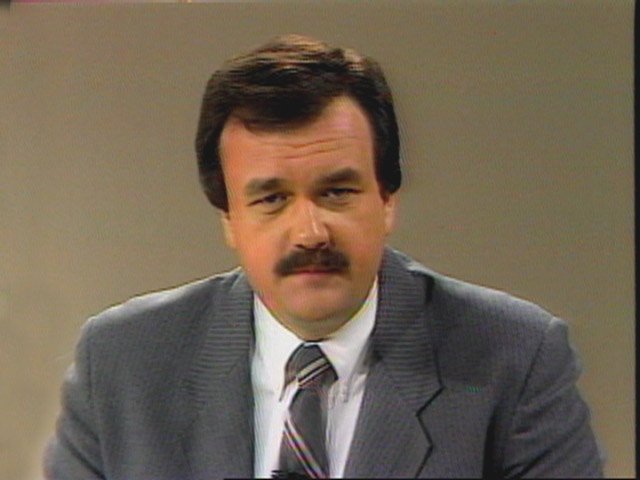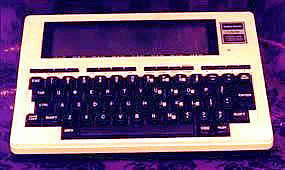Competition in Tampa Bay news leads to
computer intrigue

by Jim West
News Director, 1984-89
Spy In The Newsroom
Competition in Tampa Bay news leads to
computer intrigue

by Jim West
News Director, 1984-89
The computer
was needed for several reasons. One was to begin a library of
news clips used on the air. Heretofore, reporters and photographers kept their
favorite stories in and under their desks. There was a room piled high with
stacks of raw tapes of important stories and well as generic video. But there
was no systematized way to find anything. Were it not for Warren Elly’s
photographic mind and knowledge of the stacks of tapes, we would have been in
great jeopardy.
To bring some order, we began editing our stories on library tapes instead
of short playback cassettes. Once
full, these tapes would become a library of completed video used on-air and data
associated with the story including key words would be entered into a very
flat-file database. This was a long way away from meta-tags that are used today,
but it worked fairly well.

The Radio Shack TRS80 computer
In
the late 1980's, we began equipping reporters with laptop computers.
The Radio Shack TRS80-100 had a meager amount of memory; about enough to
hold 50 typed scripts. While
primitive by today’s standards, they
worked well enough to send scripts electronically back to the studio for
approval via a simple phone/modem setup.
This
was also a time when cellular phones first made their appearance. Before that,
two-way shortwave radio was the only way to communicate with the newsroom from a
mobile location. Some early model cell phones were as big as lunch boxes, but
they were battery powered and most importantly, mobile. We
bought cell phones that had a phone jack built-in, so we could plug into the
laptops. Amazingly it worked! Most of these phones were built into the live
trucks, and provide another example of Big 13’s continued use of advancing
technology.
We
kept our eyes on the various newsroom computer systems that were coming to the
market. Word processing made a lot of sense in a newsroom, since we spent a fortune in
paper packs (specially printed packs of 5-6 sheets each) which were often
trashed in the course of writing a story. Furthermore, the cost of the
large-type typewriters and maintenance was constant. Perhaps most important was
the convenience of word processing
that enabled last-minute changes to scripts and positioning of stories in the
format of a newscast.
There
were some early newsroom computer solutions that we examined. ComPrompter’s
Ralph King came to our station to demonstrate his system built at that time on
an Apple platform. At successive RTNDA conventions, the newsroom computer
systems made a constant evolution as technology permitted. In 1988, we embarked on an exciting path to computerize the newsroom…but a
course that would also result in a major scandal in the market.
After
months of study and deliberation, we picked a Basys computer system. Built on a
centralized hub of servers from Digital Equipment Company (DEC), their mini-Vax
line. The assignment desk, reporters and anchors all were equipped with
terminals to access the system. We added two high-speed printers, which would
print multi-sheet paper packs, but only once, adding to our savings.
The
software contained some interesting features such as a primitive
version of Instant Messaging. There also were templates for use by Assignment
Editors, Producers, etc. and well as extensive library capability to recall
previous stories when needed.
There
were a number of ways to access the system remotely over the phone since
the Internet and Wide Area Networks were still virtual unknowns. Remote access
was possible using the similar “dumb” terminals but there was also another
gateway available for use by the growing number of PC’s. In fact, I could
access the system from my home 40 miles away and look at the assignment list and
the show rundowns long before they aired. Unfortunately, as we later found out,
so could others!
We
sent two of our most technically astute news employees to Basys training. Michael
Shapiro, then Assignment Manager, and Cary Williams, who was to oversee the
system as Operations Manager. They did a wonderful job of learning the ins and
outs of the system and spent weeks training the staff in its use.
A
few months after in implementation of the computer system, Shapiro announced he
was accepting a position as Assistant News Director for one of our competitors,
WTSP. He gave his two weeks notice. Perhaps more out of kindness than better
judgment, I allowed him to work out his notice until the last day.
Knowing
that Shapiro played a big role in setting up the system, we made sure all
of his passwords and access was closed. Case closed, but not quite.
Weeks
later, in the fall of 1988, a morning show producer called
At
this point a criminal investigation was launched. The case was turned over to
the Florida Department of Law Enforcement (FDLE). By the end of that year, a
solid case of corporate espionage had been built against Shapiro and WTSP News
Director Terry Cole. I remember one visit to the FDLE, during which I was shown
files from the personal computer I kept in my office. That computer was not
networked, so the only way to have acquired those files was for someone to have
broken into my office and copied them. Those files involved contracts and other
sensitive information. Some reportedly were found as paper printouts behind a
dumpster at WTSP.
In
January 1989, the computer spy case received national publicity. The
stations lawyers were building a very strong case against a competitor. But
rather than a protracted court battle, both sides agreed to settle. Shapiro and
his News Director were fired and a six-figure financial settlement between the
stations was arranged. Computer-Gate was over. We had been “bytten”, but the
offending parties paid a hefty price. We later learned that Shapiro allegedly
used a temporary password to gain access, one which inadvertently not been
changed.
This
case also changed how Basys (now Avid) handled security issues. Computers in the
general workplace, and accordingly, security, were going through a seminal stage
in the late 1980's. According to
In the following years computerization of the newsroom became
ubiquitous. From an assignment editor's desk to a reporters first notes to the script appearing on the
TelePrompter, computers provide the pathway for the modern television newsroom.
BIG 13 thanks Jim West for this comprehensive look at WTVT news in the 1980s.
To read Jim West's
story about first WTVT Co-Anchors, CLICK HERE
To read Jim West's story about the dawn of satellite news, CLICK HERE
To return to news menu, CLICK HERE
To return to main menu, CLICK HERE